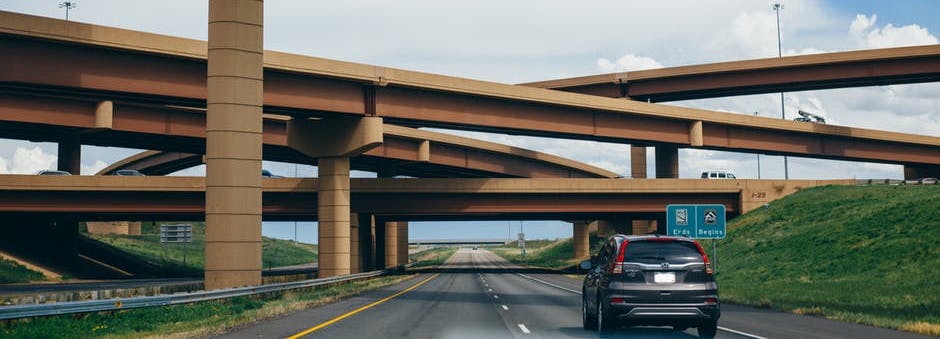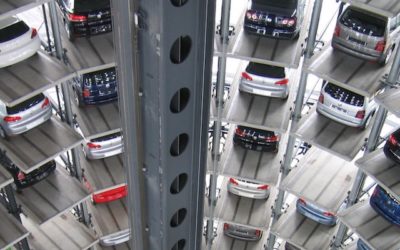There’s a lot of buzz these days about Autonomous Vehicles (AVs), also known as “driverless” or “self-driving” cars. Here’s a quick introduction on what they are, and why everyone is so excited about them.
What does “Autonomous” mean?
The Society of Automotive Engineers (SAE) has outlined definitions of six levels of vehicle automation. But when most people talk about Autonomous Vehicles, they’re only talking about the last level: full automation. The important thing to know is that at that point, a driver is completely unnecessary. The vehicle can do everything itself.
But “autonomous” doesn’t just mean moving without a driver. It also means making decisions about how to perform that task without help. Imagine you are the boss of an employee and you give that person autonomy: you assign a goal, and you don’t care how the goal is reached as long as it is completed. For a self-driving car it’s the same. The car gets assigned a destination (and perhaps operating parameters), and it is up to the car to navigate safely along roads and around obstacles to get there.
How close is self-driving technology?
Many forms of vehicle automation already exist, and are being incorporated by certain automobile makers into their latest models. Although no fully-autonomous systems are yet ready for market, the technology to perform many of the goals of autonomous vehicles has already been created, and the detailed process of testing and refining is well underway in a heated competition among those companies involved.
What should be pointed out, though, is that there are many levels to success for AV creators. For instance, it may be significantly more difficult to achieve some goals than others. Designing a driverless car that can safely and successfully operate within a designated area (such as a limited section of a city) and only in good weather conditions is possible much sooner than one expected to operate anywhere, in any conditions. While safety is always a priority, other factors such as flexibility of use and adaptability to unusual circumstances may be negotiable and depend on the purposes for which a particular AV is being created.
In short, some abilities will come sooner than others. Both for reasons of technological difficulty and investment priorities, we can likely expect simple uses with the highest economic value to appear first. As I will discuss further momentarily, this will probably include taxi, bus, and eventually delivery services, starting in the most accommodating areas.
How will driverless cars be different from current cars?
Other than their operating abilities, the only thing that needs to be different about driverless cars is the electronic equipment they carry, including extra sensors, communication equipment, and a powerful computer. Most AVs currently being tested are actually standard factory-line automobiles that have been converted with the addition of this equipment. They still look like normal cars, they still run on gasoline, and they still carry people and cargo in the same way.
But the really interesting thing about AVs is how they could be different from manual-driven cars. If a vehicle was designed to only be operated autonomously, then many components such as the steering wheel and pedals could be eliminated entirely. In fact, if manual-driven cars were completely replaced or separated from them, the increased safety could even allow self-driving cars to be made smaller and with thinner and lighter materials.
Finally, because drivers would no longer be necessary, it could be possible to create vehicles specifically designed for transport and delivery of cargo that look nothing like today’s automobiles. Seats, windows, and comfort amenities could all be removed, creating mobile transportation boxes that navigate on their own, and custom vehicles of all sizes could be built to deliver even small items relatively quickly and cheaply. There would be no reason people’s online orders and take-out food couldn’t be zipped to their door by small driverless pods.
How might Autonomous Vehicles change the world in which we live?
If drivers are no longer needed, a few things immediately change. First, anyone employed as a driver is out of a job. This would affect millions of people, with 3.5 million truck drivers and 200,000 taxi drivers in the US alone. Second, those modes of transportation that used to include the cost of a driver will all become cheaper, assuming an autonomous version of the same vehicle costs the same. This means that freight shipping, taxis, and buses all become significantly less expensive to operate, which means they can either become much more profitable or much cheaper to hire (or both). This is likely to lead to many more vehicle miles travelled (VMT) for trucks and taxis, as they will now make economic sense for many more uses.
However, one possibility is that an increased use of taxis will lead to a reduction VMT for private automobiles and ultimately a reduction in car ownership. If this were to happen it could be devastating to car sales, but great for cities wishing to ease demand for parking. Furthermore, if these taxis followed a shared-occupancy model (such as Uber Pool), it could effectively act as a form of public transit that would reduce the number of vehicles needed on the road, thus reducing traffic, vehicle emissions, and energy usage.
But again, the first issue that proponents of autonomous vehicles point to is safety. Most automobile accidents are due to human error, and it appears likely that replacing manual-driven cars with driverless cars on a broad scale could reduce the number of accidents, injuries, and roadway fatalities significantly.
At this point, however, many of the details of autonomous vehicles have yet to be worked out, and many will depend on outside factors such as government regulation and public infrastructure. This means that we must make important choices now about the future we wish to see. These technologies may soon offer a variety of new transportation possibilities, but it will be up to us as citizens, consumers, and community members to make decisions about how those technologies should be put to use.
More Articles on Automated Vehicles:
The Surprising Downside to Driving
The car is the perfect transportation device. It takes me anywhere, anytime I want, effortlessly and fast…
read moreAVs might not be the biggest change coming to city transportation
AVs are being hailed as the solution to our transportation problems. But the biggest wins may lie elsewhere.
read moreWe can do a lot without AVs
AVs are coming… but we don’t have to wait
read more



